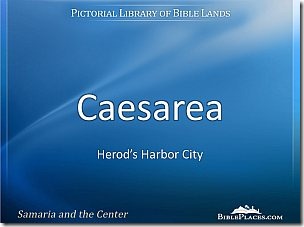Today’s BiblePlaces Newsletter features a sale on everything we produce and a free collection of photos of Caesarea. 
From Heritage Daily:
One of the complex sites contains a distinct, four-sided, truncated, pyramidal shape that is approximately 140 feet in width. This site contains three smaller mounds in a very clear formation, similar to the diagonal alignment of the Giza Plateau pyramids. The second possible site contains four mounds with a larger, triangular-shaped plateau. The two larger mounds at this site are approximately 250 feet in width, with two smaller mounds approximately 100 feet in width. This site complex is arranged in a very clear formation with the large plateau, or butte, nearby in a triangular shape with a width of approximately 600 feet. The sites have been documented and discovered by satellite archaeology researcher Angela Micol of Maiden, North Carolina. Angela has been conducting satellite archaeology research for over ten years, searching for ancient sites from space using Google Earth. Angela is a UNC Charlotte alumnus and has studied archaeology since childhood. Google Earth has allowed her to document many possible archaeological sites, including a potential underwater city off the coast of the Yucatan peninsula that has sparked the interest of scientists, researchers and archaeologists. Angela is also a board member of the APEX Institute, founded by archaeologist William Donato, who is pioneering underwater archaeological research in the Bahamas. Angela has been assisted by Don J. Long, fellow APEX researcher and colleague.
The full story includes photos and a link to more of Micol’s discoveries. HT: Jack Sasson
- Tagged Discoveries, Egypt, Technology
From the Jerusalem Post:
The Jerusalem Biblical Zoo and the Jerusalem Municipality announced on Sunday a NIS 80 million initiative to create Israel’s largest aquarium at the zoo. The aquarium, expected to open in 2015, will hold 2 million cubic meters of seawater in a number of large tanks. The highlight of the exhibit will be an underwater tunnel where visitors can walk underneath the aquarium and see a 180-degree view of the sharks, sea turtles, coral reefs and exotic fishes. The two largest tanks will focus on life in the Red Sea and the Mediterranean, while 30 smaller tanks will feature small habitats…. “Jerusalem will be the first city where there will be both the Red Sea and the Mediterranean Sea, and people won’t be able to say anymore that Jerusalem doesn’t have the sea,” Mayor Nir Barkat said.
The full story is here.
With the discovery of a LMLK seal at Azekah, Omer Sergi of Tel Aviv University gave an impromptu lecture about LMLK seals. Daily updates by volunteers are posted here.
“Archaeological sites that currently take years to map will be completed in minutes if tests underway in Peru of a new system being developed at Vanderbilt University go well.”
Egyptian officials are trying to bring back tourists by opening new tombs, including the tomb of Meresankh.
An Israeli journalist has filmed a mass grave near the Golden Gate that he suggests dates to the Roman destruction of Jerusalem.
Like the tower of Pisa, the Colosseum of Rome is leaning.
James Mellaart, excavator of Çatalhüyük, passed away this week.
More than a hundred people gathered at the tomb of Sir Flinders Petrie this week to celebrate the 70th anniversary of his death.
The latest in the wider world of archaeology is reviewed by the ASOR Blog.
Congratulations to Geoff C. and Frank P., winners of Walking in the Dust of Rabbi Jesus.
HT: Jack Sasson, Wayne Stiles, Joseph Lauer
- Tagged Discoveries, Excavations, Giveaway, Italy, Jerusalem, Shephelah, Turkey, Weekend Roundup
The on-going excavations of Megiddo are the subject of a report by Nir Hasson in Haaretz. The story focuses on the 10th-century debate but mentions a similar text-archaeology problem in the 15th century.
Archaeologist Israel Finkelstein is leading his sweating guests to a corner of Tel Megiddo. He points to a black stain on a rock, which on closer inspection turn out to be charred seeds. “This,” he says, “is the most important find at Tel Megiddo.”
[…]
In one of the four excavation areas on the mound, each marked by its own flag, we come back to the charred crumbs Finkelstein says were the mound’s most important find. Here, under a rainbow flag, we are told they are tiny seeds that Megiddo’s inhabitants collected around 3,000 years ago. They went up in flames when the city was destroyed.
They are important because of their location in relation to finds above and below them. Organic material like this is especially valuable because it can undergo carbon-14 testing, allowing the level where it was found to be dated.
[…]
One of the black layers indicates destruction in the 10th century. Finkelstein’s detractors say David destroyed this city – an idea that Finkelstein rejects because he says the carbon-14 dating rules out the possibility that the city was destroyed suddenly. It shows a gradual process.
The difficulties in reconciling text and archaeology are not limited to the Bible. Those who have great confidence in archaeology and their interpretation of the material remains tend to denigrate textual accounts.
Not far away, under a Jolly Roger, a group is excavating fortifications. Here, the finds also defy an ancient text. But this time it’s not the Bible, it’s the Egyptian record of the conquest of Megiddo by Pharaoh Thutmoses III in the 15th century BCE, describing a seven-month siege.
But the excavators discovered that the city walls at that time were meager. Finkelstein explains the discrepancy as he does with the Bible. The Thutmoses text was written to glorify the pharaoh’s vanquishing of a supposedly mighty city.
This proposal is less satisfying when considered more carefully. According to Thutmoses’ own records, his army surprised the Canaanite forces when they traveled through the Megiddo pass (Nahal Iron). With the Canaanite soldiers positioned near Jokneam and Taanach, Megiddo was an easy target. Yet the Egyptian soldiers pursued plunder and the Canaanites were able to escape into the safety of the city walls. A seven-month siege was required to take what could have been easily captured with some basic army discipline. While Thutmoses III certainly was glorified by his ultimate defeat of the Canaanite coalition, it is not easy to understand why he would have invented such an embarrassing story.
The full story is here. The Hebrew version includes a slideshow with 6 photos of the excavations.
Some day I’ll explain why many scholars reject Finkelstein’s dating of 10th-century remains at Megiddo.
HT: Joseph Lauer
- Tagged 10th Century, Excavations, Jezreel Valley
This week we have two copies of the excellent Walking in the Dust of Rabbi Jesus to give away, courtesy of Zondervan. I have already heaped effusive praise upon this book earlier in the year, and
I’ll quote just briefly from what we said then:
This book brims with insights. I love to learn new things about familiar and dear subjects, and again and again I found myself writing in the margin an exclamation mark or a reminder to return to that page.
Amazon has dozens of five-star reviews, many of which communicate the value of the book better than I have. The author, Lois Tverberg, also has a website with excerpts, articles, and a blog.
We have one drawing from which we will select two winners at random.
You may enter the drawing one time only. Email addresses will be used only to notify the winners. The contest ends on Friday.
Search
About the BiblePlaces Blog
The BiblePlaces Blog provides updates and analysis of the latest in biblical archaeology, history, and geography. Unless otherwise noted, the posts are written by Todd Bolen, PhD, Professor of Biblical Studies at The Master’s University.
Subscribe
Tags
10th Century
American Colony Photos
Analysis
Antiquities Trade
Dead Sea
Dead Sea Scrolls
Discoveries
Egypt
Excavations
Forgery
Galilee
Greece
Holidays
Israel's Coast
Italy
Jerusalem
Jezreel Valley
Jordan
Jordan Rift
Judah
Lebanon
Lectures
Mediterranean Islands
Mesopotamia
Museums
Negev
New Exhibits
Persia
Philistines
Photo Resources
Picture of the Week
Pseudo-Archaeology
Resources
Sad News
Samaria
Shephelah
Syria
Technology
Temple Mount
Tomb of Jesus
Tourism
Travels
Turkey
Weather
Weekend Roundup
Links
Notice
As an Amazon Associate we earn from qualifying purchases. In any case, we will provide honest advice.